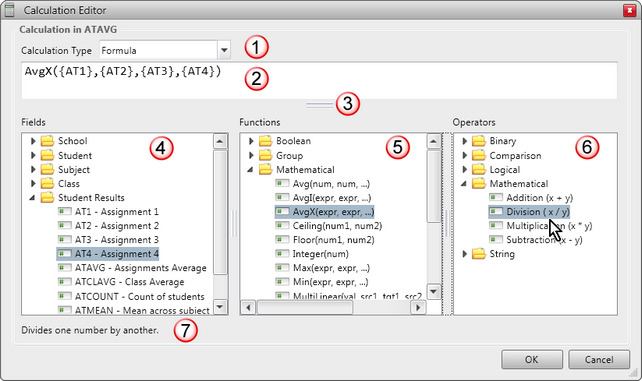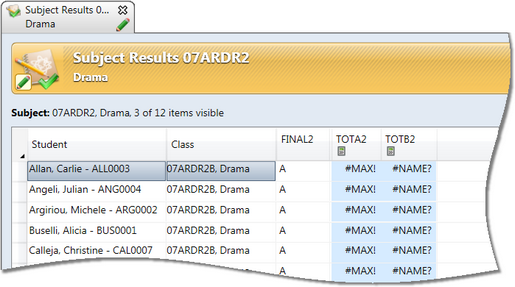
#
|
Feature
|
1
|
When adding assessment items, from any location where calculations may be be added to them, and the Formula calculation type is selected, the Calculation Editor is displayed.
If a formula has already been added, it will automatically be displayed in this window.
There is no Calculation Type field when the Calculation Editor is invoked from the Analysis window, however.
|
2
|
The calculation is composed in the top pane. It may be typed directly into the pane, or available fields, functions and operators from the panes below may be inserted into it. The formula must have the correct syntax for the functions used. White space, including line feeds, in the formula may be used to make it easier to read and these are ignored when the formula is run.
|
3
|
The relative size of each of the panes may be changed by clicking and dragging the resizers between them.
|
4
|
The Fields pane contains a tree of all of the available fields for insertion in calculations. These are grouped in folders by entity type and, within each grouping, there may be further subgroupings of fields, until the fields are displayed.
The available fields will vary, depending on:
| • | The window in which it has been activated, ie a subject, class or an analysis window. |
Subject and class windows deal with results in assessment items, that apply to particular subjects and classes and, therefore, the fields available are specific to the particular subject and classes. On the other hand, analyses deal with the whole database and the fields are more generic.
| • | In the case of analyses, the entity type, the point in the analysis at which the Calculation Editor has been invoked and if user defined fields have been added, will make different fields available. |
It is recommended that available fields are double clicked to insert them into the formula box, to ensure that they are spelt correctly, surrounded by braces, etc.
|
5
|
A wide range of functions is available, with the required syntax displayed beside each, eg AvgX(expr, expr, ...).
The functions are organised within folders, eg Mathematical, String etc. Each of the functions in the Calculation Editor, together with its syntax and example usage, may be accessed by clicking here.
Functions may be typed in or double clicked to insert them into the formula pane.
|
6
|
The right most pane contains all of the operators that may be used when building a calculation, eg =, OR, &, etc. These are also grouped in folders, based on their type, eg Mathematical, Logical, etc.
These may be typed in or inserted from the Operators pane by double clicking.
|
7
|
When a specific item is clicked in the Fields, Functions and Operators panes, a brief description of the item is displayed below the three panes. For example, above, the Division operator has been clicked and the description informs you of its usage.
|
|

